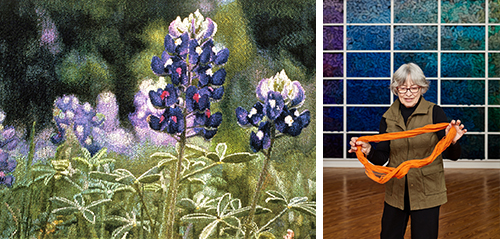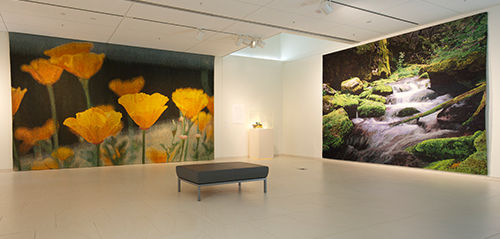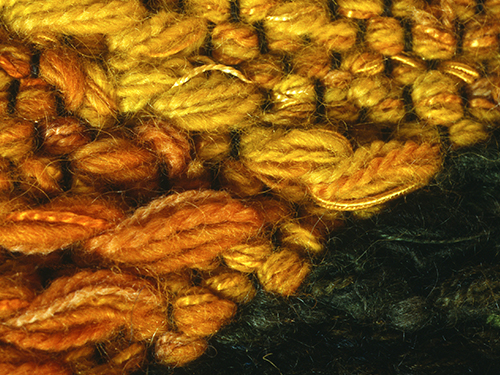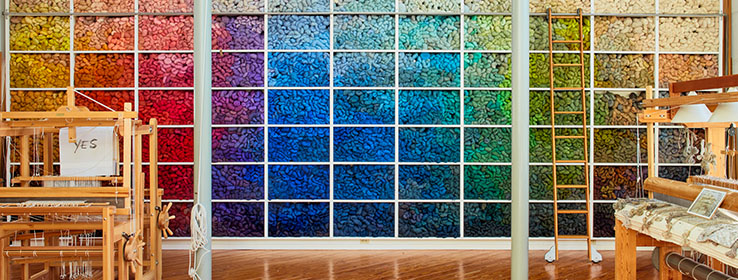Go inside textile artist Helena Hernmarck’s Connecticut studio and see how she puts color to magnificent use.
Precisely conveying the colors of nature doesn’t come easily for many artists. But textile artist Helena Hernmarck has perfected the technique like few others in her field. Her monumental tapestries — some measuring upward of 800 square feet — mesmerize the viewer with color. Some are abstract, but most are remarkably photorealistic, with trees, flowers and other elements of nature woven using hundreds of colors of wool thread. Hernmarck points to the wool butterflies in the approximately 5-by-5 foot tapestry she’s working on now as an example. Each one of the 80 butterflies consists of up to 12 different colors of thread, and she shifts the colors ever so slightly for all of them. “So you can figure on 960 different colors of thread and as many as 1,000 in a tapestry of this size,” she says.
It’s no wonder, then, that one of her most impressive tapestries — of Bay Street in Toronto, a departure from her nature-inspired works — is part of the exhibition “Scandinavian Design and the United States: 1890-1980.” Opening at the National Museum in Stockholm this month, the exhibition was organized by the Los Angeles County Museum of Art (LACMA), where it will be on view starting in October 2022.

Textile artist Helena Hernmarck uses a ladder to find wool skeins she needs to weave her tapestries. A single tapestry often includes yarn from hundreds of skeins in different colors and textures.
STIR connected with Hernmarck at her studio in Ridgefield, Connecticut, where a dramatic “wool wall” (above), as she calls it, includes more than 2,000 colors to support her work.
How were you introduced to weaving?
I grew up in Stockholm, Sweden, where my father was curator of decorative arts at the National Museum. He watched me not doing very well in school but always drawing and doing designs. So when I was 17, he took me to visit the weaving studio run by Alice Lund in Borlange, Sweden. She was called a lyrical functionalist, meaning she did not follow the folk-art types of design ideas. She was in with the modern architects, and I was very impressed. And then a little later, back in Stockholm, my father was hanging an exhibition with her work, and he allowed me to help hang it. I was very fortunate to grow up in this kind of environment.
From there, did you attend art school?
I took six months of hand weaving, followed by four years in an art school. It was not yet an academic program then but more like a vocational school where everyone practiced their skills. And then I did some summer sessions as an apprentice to Alice Lund. She saw my first carpet and she said it was one of the best carpets she had seen made, so that was a big compliment.
After your time in Sweden, you moved to Canada before coming to the U.S., right?
Yes. I arrived in Montreal three years before Expo 67, and that was fantastic timing because I landed two big commissions — one for the National Film Board of Canada and the other for the Place des Arts performing arts complex. They were 20 feet long and in public spaces where they could be seen from a distance. They were very colorful and abstract.

“Bluebonnets” (left), woven for the city of Dallas, is now in the collection of the Cleveland Museum of Art. It and all of Hernmarck’s tapestries use yarn that was spun and dyed at a mill in Sweden, which produces skeins such as the one she is holding (right).
When did your work become more photorealistic?
In the 1970s, after my first husband and I moved to Montreal. I worked in photorealism for quite some time, but my first really big job was for the city of Dallas. For that, I would weave flowers because it was around the time Lady Bird Johnson was planting flower seeds along the roads in Texas. One of those tapestries depicted colorful orange poppies and was based off a photo with the flowers against a building with dark glass. The photo really showed up against that background, and they were partly in and partly out of focus. And then I had to make a mate for it, and that obviously had to be bluebonnets, the state flower of Texas. They are now in the collection of the Cleveland Museum of Art.
Many of your works are in museum collections. But others are on display in high-profile commercial buildings. How did that happen?
You have to have luck and you have to have timing, and my timing was good because the architects I went to visit in the 1960s and ’70s were all enamored with Scandinavian design. So they were willing to see me, and then they were willing to suggest a tapestry in the lobby of one of their buildings, for example. The architect had to talk the client into it, but the architects and clients I worked with often had very good relationships. I’ve worked with architects from Philip Johnson to I.M. Pei and Partners to David Childs, [now chairman emeritus] at SOM [Skidmore, Owings & Merrill].

“Poppies” and “Mossklyftan” were exhibited at “In Our Nature: The Tapestries of Helena Hernmarck” at the American Swedish Institute in Minneapolis in 2012. For “Poppies,” Hernmarck worked off a photo taken by a student at ArtCenter College of Design in California. For “Mossklyftan,” she worked with a photographer in Sweden to find the perfect photo of a forest in the Dalarna region of the country.
You’ve worked a fair amount with Childs in recent years, right?
I’ve worked with him on several locations, including four tapestries for the residential lobby at the Time Warner Center in New York. They’re four scenes from Central Park, but only one is displayed at a time — so every three months, as the seasons pass, the next tapestry showing the changing colors of Central Park goes up. I also worked with him on two tapestries at Hudson Yards that are 8 feet wide, with 13 feet on the wall and 15 feet on the ceiling that also depict colors of nature and are changed twice a year.

A close-up view of “Poppies” shows Hernmarck’s level of detail and weaving technique. “Put simply, I use two tabby [plain] picks and one pattern pick that jumps over more warp yarns and then goes under and comes back up where you need it,” Hernmarck says. “Both the thinner tabby weave and the thicker pattern can be divided into dark and light colors. So every centimeter or inch you go, you’re looking at it and deciding, ‘Is this the color I want here?’ You have to make those decisions continuously, all day long.”
Your studio in Ridgefield, Connecticut, where you’re working right now, is a colorful work of art itself. Tell us about it.
It was designed and built by my [late] husband, Niels Diffrient, who was initially a product designer and partner at Henry Dreyfuss Associates. He did designs for things like John Deere tractors and American Airlines cabin interiors. By 1982, when he built the studio in Ridgefield, he had started his own business of designing office chairs, which Humanscale still have in production. The studio is 4,700 square feet, and about 60% was for weaving and 40% for his industrial design. My team and I have four looms at the moment, and the wool wall is 14 feet high and 30 feet wide. We have more than 2,000 colors and some 3,000 pounds of wool there.
Wow! The color alone must be inspiring.
It’s very colorful around here. And it’s infinitely fascinating because you can spend the whole day focusing on weaving and forget everything else. You are sort of in heaven, working with all of these colors.
See more photos of Hernmarck’s work at Sherwin-Williams Design Pros on Instagram.
Photos by Ross Mantle and Norman McGrath







